by R.K. Campbell | Contributing Editor
Specifications
AREX Rex Zero 1
Caliber: 9x19mm
Action: DA/SA, semi-automatic
Trigger Pull Weight: 12.5 lbs. DA, 4.5 lbs SA
Barrel Length: 4.3″
Overall Length: 7.7″
Height: 5.7″
Width: 1.1″ frame width
Weight: 29 oz
Capacity: 17+1
MSRP: About $600
Some handguns are copies of proven pistols, made to sell more cheaply. Some are genuine improvements. The AREX Rex Zero 1 in 9mm is an interesting handgun with much to recommend, and a handgun that while affordable offers excellent performance.
The pistol is billed as the first handgun manufactured solely in Slovenia. (Slovenia is bordered by Austria, Croatia, and Italy. The population is just over two million.) Arex has considerable experience in manufacturing military gear and parts. The pistol has an obvious resemblance to the SIG P 226. When you are building your first handgun it makes sense to build it upon sound design and operating principles. AREX did not promise innovation but rather affordable performance and features that set the pistol apart from the original SIG design. They have succeeded.
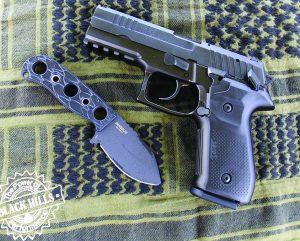
The AREX Rex Zero 1 is a formidable handgun on all counts.
The pistol operates on the locked breech short recoil principle; no surprises there. The pistol is fired with a long double-action trigger press that cocks and drops the hammer. The slide recoils, cocking the hammer for subsequent single-action fire. There are operating differences between this handgun and the SIG. Some may find the differences offer an advantage over the SIG. Others will not.
If you attempt to handle the pistol like a SIG P 226 you are OK only up to a point. Attention to detail is necessary. As a rough analogy unlike the many 1911 clones that handle in an identical manner the various SIG clones and near copies, in common with CZ clones, have different features. That being said, if you like the SIG P 226, you will like this pistol. The controls of the pistol are in the same location but serve a different purpose. As an example, an ambidextrous manual safety is located in the position usually occupied by the SIG slide lock. (I mention the SIG often as there is no pretense that this isn’t a SIG clone.) The safety may be applied with the hammer down or the hammer cocked. This gives the handgun versatility. As an example even if you prefer off safe carry and rely upon the long double action trigger as a safety feature once you have fired the first shot and engage in tactical movement, the safety may be applied. There is no need to decock and then have to manage another long trigger press.
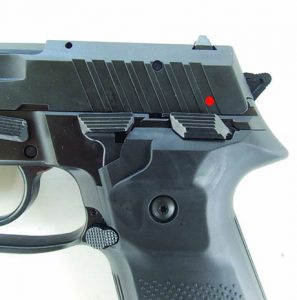
The author counts the addition of a manual safety an improvement to the design.
If you have attended training classes with the SIG pistol in attendance you may have noted that all but the best trained SIG shooters sometimes ride the thumb on the slide lock and prevent the pistol from locking on the last shot. This will not happen with the Rex Zero 1. The slide lock is now a combination lever located where the SIG decocker normally rides. The lever functions normally as a decocker to safely lower the hammer from full cock. There is a firing pin block as another safety measure. The decocking lever is pressed upward to lock the slide. When the slide is locked to the rear, the combination lever is pressed to lower the slide. A hard press to lower the slide doesn’t decock the hammer. When loading I locked the slide to the rear and pressed hard on the combination lever. The slide fell and loaded the pistol. I released the lever and then decocked the hammer. The new design is a neat improvement, in my opinion, over the original SIG SAUER design. The magazine release is fully ambidextrous. The grip frame is large for my hand and I could not actuate the magazine release without shifting my grip if using my firing hand thumb. I could easily move my forefinger to actuate the magazine release button. As I mentioned the pistol has a unique manual of arms and must be taken on its own merits.
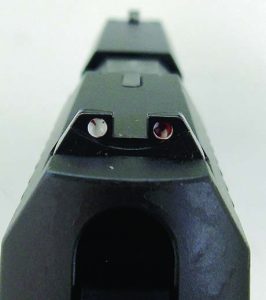
Three dot sights gave a good sight picture. The rear sight was not perfectly enameled.
The slide is similar to the P 226 and well made and finished. There are forward cocking serrations that could be an advantage. There is a loaded chamber indicator, offering a tactile chamber check. The extractor is well fitted. The barrel locks into the slide solidly without eccentric play. The sights are adequate and proved well regulated for 124-grain loads and the six o’clock hold. I would have preferred larger rear sights but it is what it is. By eyeball comparison, aftermarket sights for the SIG will not fit the Rex Zero 1. The frame is aluminum. The stippling front and rear is well turned out with good adhesion. The plastic grips are lightly pebbled. The grips are serviceable. There are sections on each side that are scalloped for easier trigger reach.
The magazines are well made and finished with no weld or polishing marks. Each holds 17 rounds. The floor plate is an aid in rapidly seating the magazine. Field strip is the same as the SIG with a takedown lever that is rotated downward to allow the slide to be removed. The instruction manual is lengthy and uncommonly well written with clear illustrations. The guide rod and recoil spring are conventional. When the piece is field stripped there were no apparent tool marks. Quality of fit and finish is high. The pistol features a light rail. The extended frame gives the pistol a monolithic look. One demerit- while the frame rail looks good and gives the pistol a pleasant forward weigh bias the rail differs from the SIG P226R. The Rex Zero 1 will not fit SIG the P226R holster. We do not know when holster makers will be up and running on this pistol, so we are limited to fabric holsters at present. As a colleague pointed out, the MK25 SIG also has a larger rail and a holster blocked for the MK25 might fit the Rex Zero.
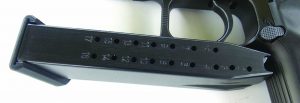
Magazines are high quality and hold 17 cartridges.
Before taking the pistol to the range I spent some time dry firing the pistol. The double-action trigger press is about 12.5 pounds with minimal stacking. The single-action trigger is good at a tight 4.8 pounds. A good trigger and sights are more important for practical accuracy than barrel fitting. The Rex Zero 1 had these advantages. I lubricated the long bearing surfaces and took the pistol to the range with a good supply of ammunition. These included lead bullet handloads, FMJ training loads, and defense loads. Initial firing was undertaken with a handload using the Missouri Bullet Company 125-grain RN with Hi Tek coating and enough True Blue powder for 1,000 fps. The pistol came out of the box running with no failures to feed, chamber, fire or eject with this load. Recoil is mild and practical accuracy good as I fired at man-sized targets at 7, 10 and 15 yards.
Accuracy testing
Load Velocity 5-shot group 25 yards
Black Hills 115-gr. FMJ 1,160 fps 2.8 in.
Black Hills 124-gr. JHP 1,060 fps 2.0 in.
Black Hills 124-gr. JHP +P 1205 fps 2.5 in.
Fiocchi 123-gr. FMJ 1,126 fps 2.25 in
Fiocchi 124-gr. Extrema 1,090 fps 2.0 in
SIG SAUER Elite 115-gr.FMJ 1,175 fps 2.75 in.
SIG Sauer Elite 124-gr.
V Crown 1,162 fps 2.1 in.
Missouri Bullets 125-gr.
Hi Tek/True Blue pdr/ 1,001 fps 2.1 in.
Missouri Bullets 115-gr.
RNL/True Blue pdr/ 1,135 fps 2.75 in.
I switched to the Black Hills Ammunition 115-grain FMJ load. This is an affordable load with good accuracy. It was more of the same, with good accuracy and function. Next, the Fiocchi 123-grain FMJ, a loading that uses the original truncated cone 9mm design. Function was good and when I turned to the steel plates this load gave the gongs an authoritative ring. During this outing I fired two defense loads. First the Fiocchi 124-grain Extrema. This load uses the Hornady XTP, a bullet with proven performance. At 1,090 fps control was good. A magazine of this load was expended at the plates with good results. Next, the Black Hills Ammunition 124-grain +P. At 1,200 fps this loading offers an excellent balance of penetration and expansion. While recoil was greater than the other loads the Rex Zero 1 remained controllable.
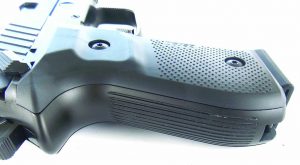
The rear grip strap is nicely grooved. Pebble grain grips give good purchase.
You cannot do a thorough evaluation of a new handgun based on one range trip. Over the past few weeks I have traveled to the range with the Rex Zero 1 and other types of ammunition. I think most of us may fire a Glock, HK or SIG two to three hundred rounds and deem it good enough to ride with. A new handgun from a lesser known maker isn’t given an easy pass. I have fired the pistol with service loads and +P and +P+ loads. The first 300 hundred cartridges were fired without cleaning. After cleaning I conducted an accuracy test, firing at 25 yards. Service gun accuracy potential is about firing at known and unknown ranges and hitting small targets, but benchrest results are interesting and show something about the pistol’s fitting and quality. I used a target with a bright orange center and took every advantage possible. As the table shows, the pistol is accurate enough for service use and would be competitive in Three Gun or IDPA competition. If you like a DA first shot 9mm that is remarkably easy to use well, with little muzzle flip and recoil, the AREX Rex Zero 1 is a contender. The controls are possibly an improvement over the SIG pistol. Quality seems comparable to any handgun on the market. The pistol isn’t cheap but it is affordable. The Rex Zero 1 gets a green light for service use.



